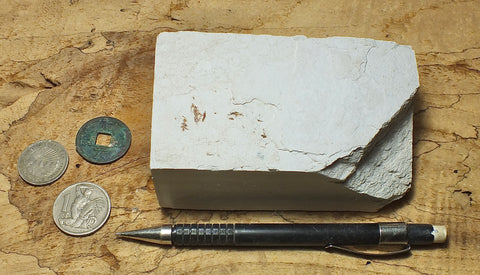diatomite - teaching hand specimen of the Valmonte diatomite, a unit of the Monterey Formation of California
$ 7.50
Diatomite or diatomaceous earth is a sedimentary rock composed of the siliceous cage-like shells of diatoms, single-celled algae that live in the shallow water of lakes and the sea. As they die there is a constant rain of their shells onto the seabed and lake bottoms, where they accumulate to form chalk-like diatomite. The shells of diatoms are made of opal, so unlike calcareous chalk, diatomite will not effervesce with a drop of hydrochloric acid.
Diatoms extract the silica of their shells from the water they live in. It takes special conditions to form a deposit of pure diatomite - active volcanism makes silica available, while very cold water inhibits the growth of foraminifera, the plankton with shells composed of calcium carbonate. Diatomite forms in high elevation lakes and in polar seas, and is found where similar conditions existed in the past.
This marine diatomite is from the Monterey Formation on the Palos Verdes Peninsula in Los Angeles County. It overlies the Altamira Shale, lowest unit of the Monterey. The Monterey Formation is the source rock for much of the oil produced in California, thanks to the diatoms. The microscopic view shows some of the diatom species found in one sample of this diatomite.
Diatomite has industrial uses in filtration, in insulation and cat litter, as a filler in rubber, paint, cosmetics and plastics, as a mechanical insecticide and as a stabilizer in dynamite. It is also used as a polishing agent in toothpaste and as a component of some cement blends.
For prepared diatom slides, we recommend Diatom Shop in Italy. Slides are available in scientific and in artistic formats, which are beautiful preparations. You can also purchase unmounted diatoms if you want to prepare your own slides. Diatom Shop has specimens from all over the world.
The hand specimens shown here are about 1 1/2" to 2" thick.
There are between 50 and 100 species in this diatomite. The microphoto shows some extracted from one sample by Anne Gleich. These specimens are collected from an extremely limited exposure.
If you are looking for attractive hand specimens for the classroom, look at the lacustrine diatomite we have in stock. Click here.
Select a specimen: When more than one specimen is shown, you can select a particular specimen by telling us what is in the photo with it, a blue or black and silver pen, a black mechanical pencil or one of those plus some number of coins, or you can let us make the selection.
Shipping: By Priority Mail or USPS Ground Advantage, whichever is cheaper, unless we find a better rate. Click > here < for shipping rates. See comment at Note! Use back button to return to this page.
Making multiple purchases? Click on the "combine shipping" button in the shopping cart. We'll send an invoice with combined shipping. A link in that invoice will bring you back to checkout, no hassle.








